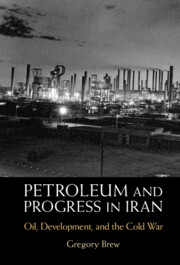Book contents
- Petroleum and Progress in Iran
- Petroleum and Progress in Iran
- Copyright page
- Dedication
- Contents
- Figures
- Acknowledgments
- Note on Transliteration
- Abbreviations
- Introduction
- Part I
- 1 Iran, Global Oil, and the United States, 1901–1947
- 2 “We Have Done Nothing”
- 3 The Mosaddeq Challenge
- 4 The Collapse Narrative
- Part II
- Bibliography
- Index
1 - Iran, Global Oil, and the United States, 1901–1947
from Part I
Published online by Cambridge University Press: 15 December 2022
- Petroleum and Progress in Iran
- Petroleum and Progress in Iran
- Copyright page
- Dedication
- Contents
- Figures
- Acknowledgments
- Note on Transliteration
- Abbreviations
- Introduction
- Part I
- 1 Iran, Global Oil, and the United States, 1901–1947
- 2 “We Have Done Nothing”
- 3 The Mosaddeq Challenge
- 4 The Collapse Narrative
- Part II
- Bibliography
- Index
Summary
In the twentieth century, Western oil companies worked to combat the oversupply of oil on world markets through oligopolistic management of production and competition. At the same time, they attempted to contain petro-nationalism in the oil-producing Global South. The rise of the Pahlavi regime in Iran threatened the Anglo-Persian Oil Company, until World War II led to the abdication of Reza Shah and the occupation of Iran, including its oil fields, by Allied forces. American advisors came to Iran determined to “cure” what they saw as a sick and unstable country, while US oil companies attempted to break the British monopoly on Iranian oil. The Azerbaijan Crisis and Cold War clarified US policy, producing an American commitment to safeguarding Iran’s territorial integrity by backing the young shah, Mohammed Reza Pahlavi, and ensuring the smooth flow of Iranian oil into the global market managed by the oil oligopoly.
Keywords
- Type
- Chapter
- Information
- Petroleum and Progress in IranOil, Development, and the Cold War, pp. 21 - 52Publisher: Cambridge University PressPrint publication year: 2022

